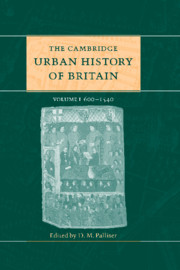Book contents
- Frontmatter
- Part I Introductory
- Part II The early middle ages 600–1300
- 3 General survey 600–1300
- 4 Power and authority 600–1300
- 5 Society and population 600–1300
- 6 The economy of British towns 600–1300
- 7 Churches, education and literacy in towns 600–1300
- 8 The topography of towns 600–1300
- 9 London from the post-Roman period to 1300
- 10 The large towns 600–1300
- 11 Small towns 600–1270
- Part III The later middle ages 1300–1540
- Part IV Regional surveys
- Part V Conclusion
- Appendix: Ranking lists of English medieval towns
- Select bibliography
- Index
- References
10 - The large towns 600–1300
from Part II - The early middle ages 600–1300
Published online by Cambridge University Press: 28 March 2008
- Frontmatter
- Part I Introductory
- Part II The early middle ages 600–1300
- 3 General survey 600–1300
- 4 Power and authority 600–1300
- 5 Society and population 600–1300
- 6 The economy of British towns 600–1300
- 7 Churches, education and literacy in towns 600–1300
- 8 The topography of towns 600–1300
- 9 London from the post-Roman period to 1300
- 10 The large towns 600–1300
- 11 Small towns 600–1270
- Part III The later middle ages 1300–1540
- Part IV Regional surveys
- Part V Conclusion
- Appendix: Ranking lists of English medieval towns
- Select bibliography
- Index
- References
Summary
At the beginning of the seventh century, nowhere in Britain could have been described as a town, a place with permanent occupants whose life styles were distinct from those of rural contemporaries. Urbanism had become established at a few sites by c. 700, but even thereafter its progress was slow and intermittent.
Although vestiges of an urban past may have survived in fifth- and sixth-century Canterbury, the new Church communities established inside and outside its walls after 597 did not stimulate rapid regeneration. An early seventh-century gold coin inscribed Dorovernis Civitas marks an aspiration to revive the city's status, and a valuable gold and garnet pendant and other objects have been found in extramural cemeteries and at intramural sites. Those who owned such things need not have lived within Canterbury, however, and occupation remained sporadic there, with one area that had already had post-Roman use even being abandoned. Sunken-featured buildings were still constructed in the style current since the early fifth century, but ground-level timber structures have also been found. Iron workers certainly continued to operate inside the walls, and another craft, pottery making, was beginning to become more specialised, but the quality of the local clays probably caused it to be extramural. Some demand for higher-quality products may have been developing, and the 675 charter reference to Fordewicum is usually taken to mean that a wic or landing-place was coming into use downstream from Canterbury on the River Stour at Fordwich, where toll privileges were granted in the next century.
- Type
- Chapter
- Information
- The Cambridge Urban History of Britain , pp. 217 - 244Publisher: Cambridge University PressPrint publication year: 2000
References
- 4
- Cited by

